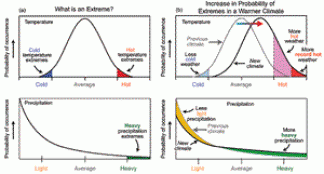North America Faces More Extreme Weather from Global Warming
June 19, 2008

Observed changes in North American extreme events, assessment of human influence for the observed changes, and likelihood that the changes will continue through the 21st century. (Credit: NOAA) (Click image for larger view)
The U.S. Climate Change Science Program and the Subcommittee on Global Change Research today released a scientific assessment that provides the first comprehensive analysis of observed and projected changes in weather and climate extremes in North America and U.S. territories. The Intergovernmental Panel on Climate Change previously evaluated extreme weather and climate events on a global basis in this same context. However, there has not been a specific assessment across North America prior to this report.
Michael Wehner, a climate modeling researcher in Berkeley Lab’s Computational Research Division, was one of the lead authors of the report, which was edited by Thomas R. Karl of the National Oceanographic and Atomospheric Administration (NOAA), Gerald A. Meehl of the National Center for Atmospheric Research (NCAR), Christopher D. Miller of NOAA, and Susan J. Hassol, Anne M. Waple, and William L. Murray of STG, Inc.
Among the major findings reported in this assessment are that droughts, heavy downpours, excessive heat, and intense hurricanes are likely to become more commonplace as humans continue to increase the atmospheric concentrations of heat-trapping greenhouse gases.
The report is based on scientific evidence that a warming world will be accompanied by changes in the intensity, duration, frequency, and geographic extent of weather and climate extremes.
“This report addresses one of the most frequently asked questions about global warming: what will happen to weather and climate extremes? This synthesis and assessment product examines this question across North America and concludes that we are now witnessing and will increasingly experience more extreme weather and climate events,” said report co-chair Tom Karl, Ph.D., director of NOAA’s National Climatic Data Center in Asheville, N.C.
“We will continue to see some of the biggest impacts of global warming coming from changes in weather and climate extremes,” said report co-chair Gerry Meehl, Ph.D., of the National Center for Atmospheric Research in Boulder, Colo. “This report focuses for the first time on changes of extremes specifically over North America.”

Most measurements of temperature (top) will tend to fall within a range close to average, so their probability of occurrence is high. A very few measurements will be considered extreme and these occur very infrequently. Similarly, for rainfall (bottom), there tends to be more days with relatively light precipitation and only very infrequently are there extremely heavy precipitation events, meaning their probability of occurrence is low. The exact threshold for what is classified as an extreme varies from one analysis to another, but would normally be as rare as, or rarer than, the top or bottom 10% of all occurrences. A relatively small shift in the mean produces a larger change in the number of extremes for both temperature and precipitation (top right, bottom right). (Credit: NOAA) (Click image for larger view)
The full CCSP 3.3 report, Weather and Climate Extremes in a Changing Climate, and a summary FAQ brochure are available online.
Global warming of the past 50 years is due primarily to human-induced increases in heat-trapping gases, according to the report. Many types of extreme weather and climate event changes have been observed during this time period, and continued changes are projected for this century. Specific future projections include:
- Abnormally hot days and nights, along with heat waves, are very likely to become more common. Cold nights are very likely to become less common.
- Sea ice extent is expected to continue to decrease and may even disappear in the Arctic Ocean in summer in coming decades.
- Precipitation, on average, is likely to be less frequent but more intense.
- Droughts are likely to become more frequent and severe in some regions.
- Hurricanes will likely have increased precipitation and wind.
- The strongest cold-season storms in the Atlantic and Pacific are likely to produce stronger winds and higher extreme wave heights.
About Computing Sciences at Berkeley Lab
High performance computing plays a critical role in scientific discovery. Researchers increasingly rely on advances in computer science, mathematics, computational science, data science, and large-scale computing and networking to increase our understanding of ourselves, our planet, and our universe. Berkeley Lab’s Computing Sciences Area researches, develops, and deploys new foundations, tools, and technologies to meet these needs and to advance research across a broad range of scientific disciplines.







 Instagram
Instagram YouTube
YouTube